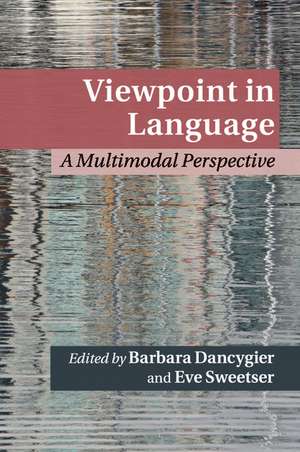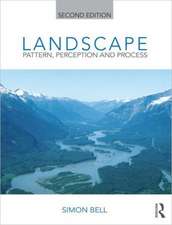Viewpoint in Language: A Multimodal Perspective: Cambridge Studies in Cognitive Linguistics
Editat de Barbara Dancygier, Eve Sweetseren Limba Engleză Paperback – 7 oct 2015
| Toate formatele și edițiile | Preț | Express |
|---|---|---|
| Paperback (1) | 333.43 lei 6-8 săpt. | |
| Cambridge University Press – 7 oct 2015 | 333.43 lei 6-8 săpt. | |
| Hardback (1) | 726.42 lei 6-8 săpt. | |
| Cambridge University Press – 11 apr 2012 | 726.42 lei 6-8 săpt. |
Preț: 333.43 lei
Nou
63.81€ • 66.44$ • 53.93£
Carte tipărită la comandă
Livrare economică 10-24 martie
Specificații
ISBN-10: 1107569303
Pagini: 254
Ilustrații: 52 b/w illus.
Dimensiuni: 152 x 229 x 13 mm
Greutate: 0.35 kg
Editura: Cambridge University Press
Colecția Cambridge University Press
Seria Cambridge Studies in Cognitive Linguistics
Locul publicării:New York, United States
Cuprins
Introduction: viewpoint and perspective in language and gesture, from the ground up Eve Sweetser; Part I. Intersubjectivity and Subjectification: 1. Irony as a viewpoint phenomenon Vera Tobin and Michael Israel; 2. Subjectivity and upwards projection in mental space structure Lilian Ferrari and Eve Sweetser; 3. Negation, stance verbs, and intersubjectivity Barbara Dancygier; Part II. Gesture and Processing of Visual Information: 4. Interactions between discourse status and viewpoint in co-speech gesture Fey Parrill; 5. Maybe what it means is he actually got the spot: physical and cognitive viewpoint in a gesture study Shweta Narayan; Part III. Multiple Viewpoints in American Sign Language: 6. Reported speech as an evidentiality strategy in American sign language Barbara Shaffer; 7. Two ways of conceptualizing space: motivating the use of static and rotated vantage point space in ASL discourse Terry Janzen; Part IV. Constructions and Discourse: 8. The constructional underpinnings of viewpoint blends: the Past+now in language and literature Kiki Nikiforidou; 9. Evoking discourse spaces in speech and thought representation Lieven Vandelanotte; Conclusion: multiple viewpoints, multiple spaces Barbara Dancygier.
Recenzii
Descriere
What makes us talk about viewpoint and perspective in linguistic analyses and in literary texts, as well as in landscape art? Is this shared vocabulary marking real connections between the disparate phenomena? This volume argues that human cognition is not only rooted in the human body, but also inherently 'viewpointed' as a result; consequently, so are language and communication. Dancygier and Sweetser bring together researchers who do not typically meet on common ground: analysts of narrative and literary style, linguists examining the uses of grammatical forms in signed and spoken languages, and analysts of gesture accompanying speech. Using models developed within cognitive linguistics, the book uncovers surprising functional similarities across various communicative forms, arguing for specific cognitive underpinnings of such correlations. What emerges is a new understanding of the role and structure of viewpoint and a groundbreaking methodology for investigating communicative choices across various modalities and discourse contexts.










